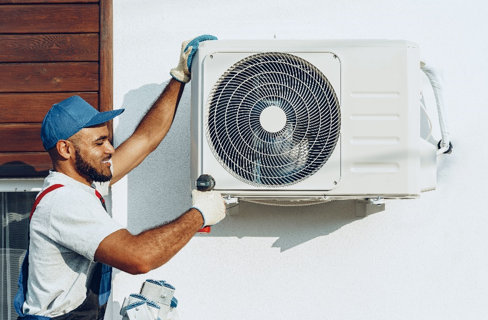Ever notice how your outdoor AC unit keeps on humming even after the inside portion of your cooling system shuts off? That’s because the outdoor condenser fan and compressor still have crucial work to do – rejecting absorbed thermal energy from inside your home out into the surrounding air.
This outdoor unit plays a vital role in the overall air conditioning cycle. Without that fan circulating air across the condensing coils, your AC loses its ability to expel interior heat gains effectively. When that fan motor fails or the fan becomes obstructed, it spells trouble for maintaining comfortable indoor temperatures.
If you’ve looked outside only to find your outdoor unit’s fan eerily still on a sweltering summer day, you’ve got a problem in need of diagnosing and resolving quickly. Whether electrical issues, mechanical breakdowns, or airflow restrictions are behind the fan failure, that non-spinning state indicates your cooling system can no longer function properly.
In this guide, we’ll investigate the primary causes behind outdoor condenser fan malfunctions and what warning signs to watch for. We’ll cover key diagnostic procedures for identifying the root cause along with potential repair solutions. You’ll also learn some preventative tips to maximize longevity and reliability of this critical outdoor AC component. Don’t allow a stalled fan to stall your home comfort!

How the Outdoor AC Unit Fan Works
Before we dive into the reasons why that outdoor fan might not be spinning, it’s helpful to first understand its key role in your air conditioning system’s operation. This outdoor condenser unit doesn’t just exist as an afterthought – it plays a vital part in facilitating the entire cooling cycle.
At its core, your AC relies on the circulation of refrigerant between indoor and outdoor components to transport thermal energy out of your home’s living spaces. The indoor evaporator coil absorbs heat from interior air as refrigerant inside transitions from a liquid to gaseous state.
But that refrigerant can’t simply release the absorbed heat inside – it needs to pass it off somewhere else in the cycle. That “somewhere else” is the outdoor condenser unit containing another heat exchange coil and your all-important fan.
As the hot gaseous refrigerant circulates into this outdoor condenser coil, the fan kicks into action. By drawing large volumes of air across the coil fins, it enables thermal transfer to take place. The surrounding airflow removes the heat from the refrigerant as it condenses back into liquid form, exhausting it outside before the cycle can repeat.
The condenser fan plays a crucial support role in this process. Not only does it maintain that steady airflow, but it also draws air across the compressor unit itself to prevent overheating. Without those fan blades continuously spinning, that entire heat rejection process quickly breaks down – allowing thermal energy to backdraft inside instead.
While the indoor air handler gets most of the glory in cooling your home, that outdoor fan and condenser coil are just as integral to facilitating the full cycle. When that exterior fan stops spinning, it’s essentially the same as cutting off the exhaust from an engine. Excessive heat and pressure rapidly build up, reducing cooling efficiency before the system shuts down completely to prevent any component damage.
Unique Causes of Fan Malfunction
That outdoor condenser fan motor spins reliably for years under ideal circumstances. But AC systems face some unique environmental pressures and operational demands that can eventually derail even the highest-quality components. From electrical malfunctions and manufacturing hiccups to simple wear-and-tear over time, a variety of culprits frequently conspire to grind those all-important fan blades to a dead halt when you need them most.
Power Supply Issues
Let’s start with some of the more obvious potential showstoppers – issues with the electrical supply powering that outdoor fan motor. Loose wiring connections anywhere along the circuit from the breaker box or disconnect to the motor itself can cause intermittent losses of power input.
The same goes for corroded terminals, frayed wires, or insulation damage from UV deterioration or lawn equipment strikes enabling short circuits. Any interruptions starving the motor of its crucial electrical supply will prevent those fan blades from turning.
Environmental Factors
Speaking of harsh outdoor conditions, your AC components face a constant onslaught from powerful environmental stressors like driving rains, scorching sun, and moisture/debris buildup. Flooding events can leave motors submerged just long enough to cause internal short circuits.
Intense heat radiating off roof surfaces can cause premature capacitor failure. And the constant dust and pollen baked onto components act like an insulating blanket forcing motors to work harder while reducing cooling airflow.
Manufacturing Defects
Even with quality manufacturing processes, the occasional lemon still slips through containing manufacturing defects of one sort or another. These could be anything from internal motor bearing misalignments or debris trapped inside to winding flaws, warped fan blade casting – you name it. Any slight imperfection has the potential to cause excess resistance, vibration, or electrical faults that prevent proper fan operation once installed outdoors.
Capacitor Failure
We can’t overlook the importance of that humble capacitor providing your outdoor fan motor with a crucial electrical boost for starting up efficiently. As capacitors degrade or fail due to age, thermal stress, electrical spikes, etc. the starting torque provided diminishes. This creates a scenario where the fan blades may spin freely once already spinning, but lack enough inrush amperage to overcome inertia and get turning in the first place.
Motor Issues
No examination of outdoor fan issues would be complete without looking at the fan motor itself as a potential culprit. As those hardworking motors log more and more operational hours over years of use, internal components including bearings, windings, rotors and bushings all experience accelerated wear and tear due to environmental factors. Eventually, excess friction from lack of lubrication can cause complete motor seizures leaving your fan at a dead standstill.
Wiring Problems
While we touched on loose power connections already, wiring problems warrant their own spotlight as a frequent fan failure culprit. From the outdoor disconnect box, all the way through that condenser unit’s internal wiring harness, any fraying, corrosion, nicked insulation, or critter-inflicted damage creates the potential for shorts or open circuits. And those disruptions in delivering a complete electrical path quickly bring those fan blades grinding to a halt.
Thermostat Malfunction
You might be surprised to learn your home’s thermostat plays just as vital a role in facilitating proper outdoor fan operation as the indoor air handler. If that thermostat develops sensor issues providing inaccurate temperature data, stuck relays preventing cooling mode activation, dead batteries, or electrical shortouts, it cannot deliver the crucial “fan on” signal that your exterior motor needs to do its job.
Frozen Coils
We often associate frozen evaporator coils on the indoor side with airflow issues and fan stoppages. But did you know the outdoor condenser coils can ice over too under the wrong conditions? Excessive humidity combined with low refrigerant levels frequently leads to ice accumulation on those exterior fins – eventually obstructing airflow so severely that those fan blades can no longer push through. Defrosting and addressing root refrigerant problems resolves the restriction.
Improper Installation
While shoddy workmanship from unqualified contractors should be the exception rather than the norm, improper AC installations do unfortunately occur more often than they should. Whether improperly sized components, refrigerant line kinks, ductwork imbalances, or electrical miswiring, fan motor issues can definitely manifest down the line. This stresses the importance of only hiring experienced and reputable HVAC professionals for any cooling system installations.
Control Board Issues
Your outdoor condenser unit relies on an electronic control board much like a mini computer brain to coordinate functions including fan operation based on system data and thermostat signals. When those boards start experiencing electrical issues from power surges, circuit shorts, moisture infiltration, or even manufacturing defects, they can send incorrect operation commands causing those all-important fan motors to either run constantly or not at all.
Physical Obstructions
Sometimes the reason for that unmoving outdoor fan is as simple as some kind of physical obstruction preventing the blades from turning freely. From overgrown shrubbery encroaching on the unit and making contact, to sticks, rocks, or lawncare debris getting launched inside, any external hindrance creates excess torque that can cause motors to labor or stop altogether. Rodent nests taking up residence amid fan housings present another obstruction hazard too.
Fan Blade Damage
Those hardy fan blades protect condensing coils by flinging large debris clear, but they’re not indestructible. Recurring impacts from rocks, branches, hail, or lawn care equipment can distort blade profiles over time – disrupting airflow and placing imbalanced loads on motor shafts. Serious enough damage completely sheers blades off, leaving motors futilely spinning against the stub remains unable to generate sufficient torque.
Voltage Issues
We often assume voltage consistency from our home electrical systems. But deviations can occur due to utility company issues, overtaxed transformers during peak demand periods, or problems with your home’s circuit breakers themselves. If voltage levels dip too low, those outdoor fan motors lack the minimum amperage to overcome that initial inertia and get spinning reliably.
Humidity and Condensation
Subjecting any electrical components to excessive moisture exposure increases risks of shorts, insulation damage, corrosion and general operational failures. For those outdoor fan motors tasked with spinning amid hot, humid summer conditions while surrounded by condensation from refrigerant lines, it’s an ongoing battle against the elements. Any moisture infiltration can quickly lead to stalling issues.
Wear and Tear
Finally, like any hardworking mechanical component, outdoor condenser fan motors and their associated parts simply experience gradual wear and tear with age. Bushings disintegrate, lubricants evaporate away, belts fray, bearings develop scoring – a combination of factors making those fan blades exponentially harder to spin once that fatigue accumulates over years of service life. At a certain point, full motor replacement becomes the only viable repair option.
From electrical problems and mechanical failures to environmental factors and physical obstacles, a variety of culprits can conspire to stall out those outdoor AC fan revolutions. Implementing preventative maintenance and promptly addressing root causes represent the keys to maximizing the longevity and reliability of this critical cooling system component.
Diagnosing the Problem
As with any AC issue, the first step towards resolving a non-spinning outdoor fan involves careful diagnosis to identify the root cause correctly. While some fan failure scenarios like physical obstructions or obvious damage might be fairly apparent, others require more meticulous inspection and troubleshooting. Jumping straight to repairs without an accurate diagnosis risks incomplete fixes and recurring headaches down the road.
The good news is that many diagnostic steps can be performed by reasonably handy homeowners armed with just a few basic tools and the right procedure. Of course, always prioritize personal safety by exercising caution around any potential electrical hazards. When in doubt, leave the real heavy lifting to licensed HVAC professionals with the expertise to inspect things thoroughly.
For those comfortable getting hands-on, start by giving that outdoor condenser unit a thorough visual once-over. Ensure no obstructions like vegetation, fencing, lawncare debris or fallen branches could be physically impeding the fan’s rotation. While inspecting those fan blades, check for any cracks, bends, or other visible damage that might be throwing them off balance too.
With a simple multimeter, you can check for power flowing from the housing disconnect box through the unit’s control wiring to verify no electrical supply interruptions exist. You’ll want to carefully inspect those electrical connections as well for any corrosion, fraying, or damage enabling shorts or open circuits.
If power seems to be flowing as it should, shift your focus to checking that all-important start capacitor responsible for giving the fan motor its initial spin-up torque. A multimeter can test for any capacitance drop signaling the component is underperforming or failed outright. While you’re investigating the fan motor itself, use your multimeter to also check incoming voltage levels to rule out any fluctuation issues from the electrical service.
For diagnosing potential mechanical causes like seized bearings or excessive shaft friction, you’ll need to get a bit more hands-on carefully testing fan blade rotation. If it seems to spin freely when spun by hand but won’t initiate on its own, that points to a capacitor problem. Significant resistance to rotation points towards an internal mechanical breakdown instead.
If your visual inspections and basic testing eliminate simpler root causes, start considering whether the underlying culprit might stem from more complex system issues. Refrigerant leaks, frozen coils, thermostat faults, and control board failures can all manifest in fan operation problems too. At this point, bringing in a trained HVAC technician with specialty diagnostic tools and expertise proves wise for proper analysis.
Left unresolved, that dead outdoor fan inevitably spells trouble for your overall cooling system function and efficiency. Addressing the root cause promptly not only restores comfort but maximizes equipment longevity too. Don’t let an unmoving outdoor fan become a snowballing system meltdown!
Common Solutions and Fixes
Once you’ve accurately diagnosed the culprit behind your outdoor AC unit’s non-spinning fan, the next step involves implementing the proper fix to restore normal operation. Depending on the root cause, some solutions might involve basic DIY repairs while others demand the skilled hand of a certified HVAC professional.
For those simpler scenarios like minor obstructions or electrical connection issues you can safely correct yourself, clearing away any debris and tightening loose wires typically does the trick. Any damaged fan blade discoverable by the naked eye often warrants affordable replacement with an OEM part compatible with your specific unit make and model.
When electrical faults seem to center around that mission-critical start capacitor, replacement proves relatively straightforward too. With the unit’s power supply carefully disconnected, you can typically swap out the old capacitor and snap in the new one quickly before restoring power to test functionality. More serious electrical issues like corroded wiring harnesses may require pro assistance though.
Unfortunately, mechanical problems involving the actual fan motor itself frequently mean replacement becomes necessary to dependably restore operation. While handy DIYers can sometimes achieve temporary motor bearing relubrication, any internal component damage like burned windings typically necessitates a pro install of a new compatible motor.
The same professional-grade service applies to resolving underlying system problems inadvertently stalling that outdoor fan. Anything from refrigerant leaks to control board failures usually requires specialized diagnostics and tools to properly remedy the source. Don’t risk cutting corners on subpar DIY attempts for these more intricate fixes.
Thermostat issues stemming from bad sensors, dead batteries, or miscalibrated programming commonly rank among the simplest solutions – either adjusting configurations or swapping out affordable thermostat components tends to get things spinning smoothly again in those cases. Though thermostat wiring problems may require pro expertise for full replacement runs.
No matter how seemingly straightforward a fan fix might seem, exercising precaution around exposed electrical contacts, moving components and hazardous refrigerant lines always proves wise. When in doubt, the relatively minor service fees for an expert technician provide a small price to pay for personal safety and proper long-term resolution.
With prompt repairs and preventative maintenance, that outdoor condenser fan can dependably keep rejecting thermal loads for years of unfettered cooling comfort. Don’t let a stalled fan turn into a snowballing AC meltdown – address any issues immediately!
Preventive Measures
An ounce of prevention proves worth a pound of cure when it comes to maximizing the longevity and reliability of your outdoor AC unit’s condenser fan. While correcting acute breakdowns promptly represents a crucial first step, implementing some preventative best practices provides the best defense against frustrating fan failures year after year.
At the top of that preventative checklist? Keeping that outdoor condensing unit clear of any airflow-obstructing debris and vegetative overgrowth. Maintaining a perimeter clear of any shrubbery, lawn clippings, leaves or environmental gunk ensures those fan blades can spin uninhibited without excess load-bearing strain.
Periodic cleaning and hosing off of the unit cabinet and coils not only helps optimize cooling efficiency, but it prevents excessive dust and pollen accumulation that degrades fan motor performance over time. Be sure to carefully brush off any noticeable buildup on the fan blades specifically while rotating them slowly by hand.
For heavily treed or vegetation-dense yards, consider installing an inexpensive mesh grate or filter accessory over that outdoor unit’s airflow exhaust stream. These attachments create a protective barrier preventing sticks, seeds, and other yard debris from infiltrating fan assemblies in the first place.
Of course, the most comprehensive preventative measure involves scheduling annual professional tune-ups and maintenance calls with a reputable HVAC contractor. These multi-point inspections performed by certified technicians allow for thorough diagnostic testing, cleaning, system balancing, and calibration to ensure every individual AC component remains poised to operate at peak conditions.
This preventative service typically includes careful fan blade inspection, motor amp testing, electrical connection tightening, control board testing, lubrication, and other fan-specific measures. Trained techs can also identify any concerning issues like capacitor degradation and recommend replacement ahead of complete breakdowns.
Most HVAC companies offer affordable yearly service plans too – providing no-excuse motivation for prioritizing that maintenance checklist consistently. The minor investment pays off exponentially by extending your cooling system’s overall service life while minimizing unexpected costlier repairs.
Between homeowner vigilance and professional preventative care, that outdoor condenser fan should spin like a champion reliably delivering cooling relief for years. Don’t let an ounce of forethought compromise your pound of eventual comfort and savings!
Don’t Let Fan Failures Derail Your Cooling Comfort – Trust Bassett
When your outdoor AC unit’s fan refuses to spin, it’s more than just an inconvenience – it’s a surefire sign that something isn’t right with your cooling system’s operation. From minor airflow obstructions to major electrical and mechanical breakdowns, a variety of root causes could be conspiring behind that unmoving exhaust fan.
Left unaddressed, those failures quickly escalate into accelerated system deterioration, skyrocketing energy costs, and sweat-soaked interior misery as thermal overload conditions manifest. Ensuring your home stays an oasis of refreshing respite through the hottest summer months demands prompt corrective action at the first sign of fan issues.
For homeowners throughout Ohio and Indiana, Bassett Services represents the region’s go-to team for comprehensive air conditioning maintenance, repairs, and replacement installations. With decades of HVAC industry experience, our certified technicians wield the expertise to quickly diagnose any fan fault – thoroughly inspecting electrical, refrigerant, thermostat, and mechanical components with the latest tools and methods.
But Bassett doesn’t stop at just resolving acute breakdowns either. Our full-service approach prioritizes preventative care through affordable annual tune-ups designed to maximize AC longevity and efficiency from month to month. Thorough coil cleaning, fan blade inspection, lubrication, control board testing and more – no inch goes overlooked in ensuring your system avoids disruptive problems before they occur.
Most importantly, we back our reputation for quality with steadfast customer focus providing professional service on every job. You can expect transparent communication, competitive pricing, and a workmanship guarantee that your home comfort needs will be tended to with experienced care. No frustrating runarounds or shady upcharges here.
Don’t resign yourself to sweating out another day of indoor oven conditions stemming from outdoor fan failures. Call the Bassett Services team at (317) 360-0054 and schedule your service appointment today! Our cooling specialists will promptly restore that refreshing airflow while ensuring your investment dependably keeps spinning for years to come.





